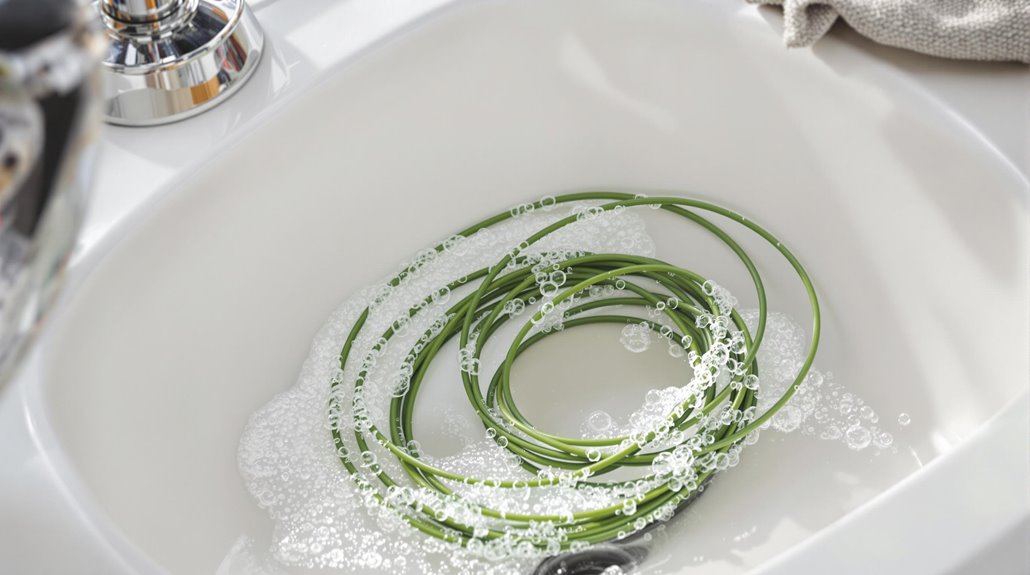I’ve spent countless hours perfecting my fly fishing technique, but I’ve learned that even the best casting skills won’t matter if your line isn’t clean. After watching my expensive fly line deteriorate from neglect, I discovered that proper cleaning isn’t just about maintenance – it’s essential for achieving those perfect casts you’re after. Let me share my proven system for keeping your fly line in prime condition, starting with the tools you’ll need.
Essential Tools and Materials for Line Cleaning

When it comes to keeping your fly line in top condition, having the right cleaning supplies is essential for maintaining its performance and longevity.
I recommend starting with a high-quality line cleaning solution specifically designed for fly lines, as household cleaners can damage the coating. You’ll also need several cleaning brushes with soft bristles to prevent scratching.
I always keep microfiber cloths handy for wiping down the line, along with a clean towel to create a safe working surface.
For deeper cleaning, I use a line cleaning tool that helps remove stubborn dirt and algae.
Don’t forget to grab a small container of pure silicone lubricant, which I’ll apply after cleaning to keep the line floating well and casting smoothly.
Signs Your Fly Line Needs Cleaning
Several telltale signs indicate your fly line needs a thorough cleaning to maintain its performance.
When I’m out on the water, I’ve learned to watch for specific indicators that tell me it’s time for some maintenance on my line.
- Line discoloration is often the first warning – if you notice your line turning a darker shade or developing a grimy coating, it’s definitely time for cleaning.
- Performance issues like shorter casts, difficulty shooting line through the guides, or the line not floating as well as it used to are clear signals that dirt and grime have built up.
- If you feel the line’s texture has become rough or sticky when running it through your fingers, or you notice it’s starting to crack in places, cleaning is urgently needed.
Quick Field Cleaning Methods
Three essential field cleaning methods can help restore your fly line’s performance when you’re out on the water.
I recommend using a clean microfiber cloth, which I keep in my vest, to quickly wipe down my line between casts.
For a more thorough field cleaning, I’ll run my line through a line cleaning pad that’s pre-treated with silicone, removing dirt and adding protection simultaneously.
If I notice my line’s getting really sluggish, I’ll use my favorite quick-fix: a small spray bottle filled with line cleaner and a clean rag to give it a proper wipe-down during breaks.
Remember to avoid harsh cleaning solutions that might damage your line’s coating, and always dry your line completely before resuming fishing.
Deep Cleaning Your Fly Line at Home

Although quick cleaning methods work well in the field, giving your fly line a thorough deep cleaning at home will greatly extend its life and performance.
I recommend establishing regular maintenance techniques based on how often you fish and the conditions you encounter.
- Start by filling your sink with warm water and mild dish soap, then run the entire line through a soft, damp cloth to remove built-up grime and algae.
- For stubborn dirt, I’ve found that using a designated line cleaning pad with special fly line cleaner works best – just be gentle to avoid damaging the coating.
- After cleaning, I always apply a quality line dressing to restore the coating’s slickness, which I find essential for ideal casting distance and performance.
Remember to deep clean your line every 3-4 fishing trips for best results.
Best Cleaning Products and Solutions
Now that we’ve covered deep cleaning techniques, let’s look at the most effective products I reach for to keep my fly line in top shape.
I prefer using environmentally friendly cleaning agents like Simple Green, Rio’s Line Cleaning solution, or Scientific Anglers’ Line Dressing, which are specifically designed for fly lines.
For a DIY approach, I mix a small amount of mild dish soap with warm water, which works well and won’t damage the line’s coating.
Avoid harsh cleaning agents like bleach, alcohol, or abrasive cleaners that can deteriorate your line.
I always keep a pack of pre-moistened line wipes in my vest for quick cleanups on the stream, and they’re perfect for removing surface grime between deeper cleanings.
Step-by-Step Cleaning Process
Following a systematic cleaning process will help extend your fly line’s life and maintain its performance on the water.
I recommend establishing a regular line care routine based on your fishing frequency and environmental conditions. You’ll want to clean your line after every few fishing trips to prevent dirt buildup and maintain peak casting.
- Start by stripping the entire fly line off your reel and running it through a clean, damp cloth to remove surface debris.
- Apply your chosen cleaning solution to a fresh microfiber cloth, then draw the line through it while applying gentle pressure.
- Make a final pass with a clean, dry cloth to remove any remaining cleaner and verify the line is completely dry before rewinding.
Proper Drying and Storage Techniques

Properly drying and storing your fly line makes the difference between equipment that lasts for years and line that quickly deteriorates.
I recommend laying your cleaned line flat on a towel at room temperature, away from direct sunlight and heat sources. Once it’s completely dry, I use specific drying techniques like gently wiping it with a microfiber cloth to remove any remaining moisture.
For storage solutions, I always coil my line loosely in loops about 12 inches in diameter, which prevents memory and kinking.
I store these coils in a dedicated line sleeve or clean plastic bag, keeping them in a cool, dry place like my fishing room or garage cabinet.
Remember to avoid cramped spaces, extreme temperatures, and high humidity, which can damage your line’s coating and core.
Line Maintenance Schedule and Tips
A regular maintenance schedule keeps your fly line performing at its best, just like the careful storage methods we covered.
I recommend implementing these essential line maintenance tips to extend the life of your fishing equipment and maintain peak casting performance.
- Clean your fly line every 2-3 fishing trips, or more frequently if you’re fishing in saltwater or muddy conditions, using a gentle soap solution and soft cloth.
- Check your line for cracks, nicks, or signs of wear at least once per month, paying special attention to the first 30 feet where most wear occurs.
- Apply line dressing or conditioner quarterly to prevent the line from drying out and becoming brittle – I’ve found this especially important in hot, dry climates where UV exposure can damage the coating.
Common Cleaning Mistakes to Avoid
While maintaining your fly line is essential, I’ve noticed many anglers make critical mistakes during cleaning that can damage their lines and reduce performance.
One of the most common misconceptions is that more cleaning equals better care, but overcleaning issues can actually strip away the line’s protective coating.
Never use harsh chemicals or household cleaners on your line, as they’ll break down the coating and core materials.
I’ve seen anglers scrub their lines aggressively with rough materials, which creates microscopic scratches that collect dirt.
Don’t leave your line soaking in water or cleaning solution for extended periods, and avoid using hot water, which can weaken the line’s structure.
Remember to always use manufacturer-recommended cleaning products and gentle, smooth strokes when wiping your line clean.
Extending Your Fly Line’s Lifespan

Beyond avoiding cleaning mistakes, taking the right steps to protect your fly line can dramatically increase its usable life.
I’ve found that line longevity depends heavily on proper handling and storage conditions, along with how frequently you use your gear.
- I recommend checking your line through regular inspections before and after each fishing trip, looking for signs of wear, cracking, or damage that could affect casting technique.
- When it comes to environmental factors, I always store my line away from direct sunlight and extreme temperatures, coiling it loosely to prevent memory formation.
- I’ve learned to recognize when line replacement is needed – if you notice persistent tangles, decreased floating ability, or visible deterioration, it’s time to invest in new line rather than risk equipment failure.







